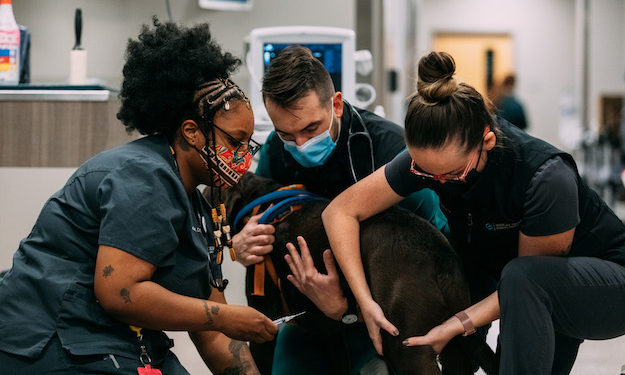Celebrating Ethos Veterinary Technicians

Licensed Veterinary Technicians (LVTs), Registered Veterinary Technicians (RVTs), and Certified Veterinary Technicians (CVTs) are essential veterinary healthcare team members who must possess professional and personal skills to assist veterinarians, care for pets, and educate and comfort pet owners. They get peed on and pooped on, bitten and scratched, and deal with scared and concerned pet owners. The pandemic placed extra strain on these hard-working individuals, and the long hours and increased workload caused many to experience burnout and compassion fatigue.
Ethos Veterinary Health values our veterinary technicians every day, but since October 16 through 22, 2022 is National Veterinary Technician Week, we would like to celebrate these hard-working individuals and honor their commitment to compassionate, high-quality veterinary care.
What Does a Veterinary Technician Do?
Veterinary technicians do everything—or at least that’s the way it often seems. Under a veterinarian’s direction, veterinary technicians have numerous responsibilities, including these routine tasks:
- Collecting case histories — When you bring in your pet for veterinary care, a veterinary technician is responsible for collecting and recording their history. Based on your information, the technician may ask educated questions to determine more about your pet’s condition.
- Performing an initial examination — The veterinary technician weighs your pet, takes their temperature, and performs an initial examination, relaying their observations to the veterinarian.
- Drawing blood — Veterinary technicians draw blood and collect other specimens for testing. Many become experts at hitting tiny kitten veins, and soothing needle-phobic pet patients.
- Restraining pets — When a veterinarian or another veterinary technician needs assistance, a veterinary technician restrains the pet to facilitate the procedure—a task that occasionally ends with soiled scrubs.
- Providing emergency first aid — During emergency situations, veterinary technicians are responsible for administering first aid, such as controlling bleeding and placing an intravenous catheter to deliver fluids and medications.
- Preparing for surgery — Veterinary technicians are responsible for preparing your pet for surgery, and for setting up the equipment necessary for the procedure.
- Taking X-rays — When your pet needs a diagnostic X-ray, a veterinary technician takes the necessary images.
- Administering anesthesia — During procedures that require that your pet be anesthetized, a veterinary technician administers the anesthesia and monitors your pet’s vitals closely to ensure they remain at an appropriate anesthetic plane.
- Educating pet owners — When discharging your pet, a veterinary technician will educate you on the necessary home care and answer your questions about your pet’s condition.
How Do You Become a Veterinary Technician?
Becoming a veterinary technician requires extensive education and training. Steps include:
1. Education
The most common veterinary technician educational path is a two-year associates degree, but some individuals opt to earn a four-year bachelor’s degree. The veterinary technician program curriculum includes education in all aspects of animal nursing and handling, including laboratory and surgical procedures.
2. Clinical training
Students are required to gain clinical skills by volunteering at a veterinary facility under veterinary professional supervision.
3. Certification
After completing their degree, students must take a credentialing examination—the Veterinary Technician National Examination (VTNE) prepared by the American Association of Veterinary State Boards. This three-hour test consists of 170 multiple choice questions on nine major subject areas, including pharmacy and pharmacology, surgical nursing, dentistry, laboratory procedures, anesthesia, animal care and nursing, pain management and analgesia, emergency medicine and critical care, and diagnostic imaging. After passing this exam, the technician is referred to as an RVT, LVT, or CVT, depending on their state of residence.
4. Specialization
Veterinary technicians can receive specialized training to obtain advanced credentials in specialties such as emergency and critical care, surgery, physical rehabilitation, and diagnostic imaging.
5. Continuing education
Veterinary technicians must participate in continuing education courses every year to maintain their certification. The number of hours required varies by state.
How Can I Show My Appreciation for Veterinary Technicians?
Veterinary technicians are hardworking, compassionate individuals, but they are also human. They have good days and bad, and while they strive to always maintain a professional demeanor, you may catch them on an especially difficult day. Ways you can express your appreciation for your veterinary technician include:
- Be understanding — Keep in mind that the long wait time is not the veterinary technician’s fault. Be patient and understanding when you bring your pet for veterinary care and treat your veterinary technician with the respect they deserve.
- Be kind — You never know what is weighing on a veterinary technician. Their previous case may have been euthanizing someone’s beloved senior pet. Always be kind and realize that your veterinary technician may be dealing with more than you understand.
- Say thank-you — A smile and a thank-you go a long way, and verbally expressing your appreciation is always helpful.
Veterinary clinics and hospitals can’t function without veterinary technicians. They perform fundamental tasks and help veterinarians work more efficiently and effectively. At Ethos Veterinary Health, we say an emphatic thank-you to all our dedicated, hardworking veterinary technicians, because we couldn’t do this important work without you.